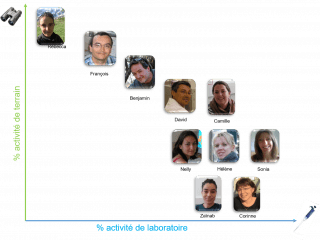Research assistance
Members

Assistante ingénieure
CNRS
Tel: 04 72 44 81 42

Ingénieure d'études
CNRS
Tel: 33 04 72 43 29 17
Technicien CDD
CNRS

Assistant ingénieur
UCBL
Adjointe technique
UCBL
Tel: 33 04 72 44 79 17

Assistant ingénieur
CNRS
Tel: 33 04 72 43 29 29

Assistante ingénieure
CNRS
Tel: 04 72 44 81 42
Stagiaire
CNRS

Ingénieure de recherche
CNRS
Tel: 33 04 72 43 29 14
Technicienne CDD
UCBL

Technicienne
UCBL
Tel: 33 04 72 43 29 15

Ingénieur d'études
CNRS
Tel: 33 04 72 44 58 72
Adjointe technique
UCBL
Tel: 04 72 44 81 42

Technicienne
CNRS
Tel: 04 72 44 81 42

Assistante ingénieure
UCBL
Tel: 04 72 43 29 14

Technicien
UCBL

Ingénieur de recherche
CNRS
Tel: 04 72 43 29 29

The “pole biotechnologique” brings together a range of bioengineering expertise for the development of tools and approaches for research in evolutionary biology; and operational competences to ensure their logistical and technical implementation.
Since it was set up, the biotechnology hub has perpetuated insect breeding activities, including several species of drosophila, but also Venturia and Bemisia for example. These breeding activities are carried out on artificial medium or plants. We ensure laboratory logistics (e.g. autoclave, stock management, ...) as well as safety aspects, and develop devices (e.g. via 3D printing) to feed experimental research in the laboratory focusing on evolutionary genomics, behavioural ecology and functional ecology.
Our expertise is also solicited to organize field work, in metropolitan France and internationally, and to carry out population monitoring of terrestrial mammals (e.g. roe deer, marmots, feral cats, bats) and birds (dipper). In addition to capture (e.g. trapping, netting), marking and monitoring of animals, we implement experimental approaches in natura, collect biometric, behavioral and physiological data, biological samples (blood, secretions, hair, faeces, biopsy, ...) and characterize the study environments (installation of sensors, aerial imaging by drones, construction of digital models of terrain ...).
Finally, the biotechnology hub offers the technical resources and skills to analyse a wide variety of biological samples in the laboratory through an multidisciplinary prism. The complementarity and synergy of our competences are expressed in the fields of molecular biology (PCR, qPCR, construction of libraries for the genesis of ohmic data), cell biology (confocal microscopy, flow cytometry), and biochemistry (characterization of metabolic, endocrine and oxidative profiles).
Rehabilitation work was done at the LBBE in 2022 and lead to a significant expansion of the experimental space. These new premises allow us to increase our capacity, to offer new spaces and modern tools dedicated to behavioral approaches. These new premises also allow us to widen the spectrum of our activities by developing new techniques (e.g. cell culture, Crispr/cas9, RNAi, ...).
In all our activities, we regularly welcome and supervise trainees and students of all levels. For any questions or information request, do not hesitate to contact us
Publications
Display of 1 to 30 publications on 259 in total
Gene and transposable element expression in response to stress in temperate and tropical populations of Drosophila
Mobile DNA . 16 ( 1 ) : 35
Journal article
see the publicationEpigenetic Clock Analysis of Sex Chromosome Aneuploidies
Aging Cell .
DOI: 10.1111/acel.70243
Journal article
see the publicationRelaxed Purifying Selection is Associated with an Accumulation of Transposable Elements in Flies
Molecular Biology and Evolution . 42 ( 6 )
Journal article
see the publicationExposure to toxic trace metals is negatively associated with testis mass in wild male roe deer
Environmental Pollution . 383 : 126325
Journal article
see the publicationContinent-wide differentiation of fitness traits and patterns of climate adaptation among European populations of Drosophila melanogaster
Evolution Letters . : qraf014
Journal article
see the publicationVariation in albumin glycation rates in birds suggests resistance to relative hyperglycaemia rather than conformity to the pace of life syndrome hypothesis
eLife .
Journal article
see the publicationPlateforme Drone & Capteurs Embarqués (DCE)
Journée des Plateformes de la FR BioEEnViS .
Poster
see the publicationReconciling Pollen Limitation Theories: Insights From Temperate Oak Masting
Ecology Letters . 27 ( 11 ) : e70009
DOI: 10.1111/ele.70009
Journal article
see the publicationContribution of variable TE content on phenotype and plasticity in Drosophila melanogaster.
Annual meeting of the Society of Molecular Biology and Evolution (SMBE) .
Conference paper
see the publicationContribution of variable TE content on phenotype and plasticity in Drosophila melanogaster.
Conférence Jacques Monod Life is plastic .
Conference paper
see the publicationFunctional analysis of interactions between bed bugs and their symbionts Wolbachia and BEV-like
International congress of Ecology and Evolution (SFE2) .
Conference paper
see the publicationContribution of variable TE content on phenotype and plasticity in Drosophila melanogaster
International congress of transposable elements .
Poster
see the publicationContribution of TE to the phenotype and plasticity in Drosophila melanogaster
27th European Drosophila Conference .
Poster
see the publicationInsect population dynamics under Wolbachia-induced cytoplasmic incompatibility: Puzzle more than buzz in Drosophila suzukii
PLoS ONE . 19 ( 3 ) : e0300248
Journal article
see the publicationWolbachia improves the performance of an invasive fly after a diet shift
Journal of Pest Science . 97 : 2087-2099
Journal article
see the publicationHaemolysis overestimates plasma oxidative stress biomarkers in free-ranging roe deer
Comparative Biochemistry and Physiology - Part A: Molecular and Integrative Physiology . 298 : 111750
Journal article
see the publicationThe transposable element-rich genome of the cereal pest Sitophilus oryzae
Preprint
see the publicationEarly-life glucocorticoids accelerate lymphocyte count senescence in roe deer
General and Comparative Endocrinology . 357 : 114595
Journal article
see the publicationTranscriptomic Response to Pyrethroid Treatment in Closely Related Bed Bug Strains Varying in Resistance
Genome Biology and Evolution . 16 ( 8 ) : evae158
DOI: 10.1093/gbe/evae158
Journal article
see the publicationSocial interactions throughout life impair longevity and age-specific mating success in male parasitoids
Behavioral Ecology and Sociobiology . 78 : 90
Journal article
see the publicationLiver mitochondrial coupling efficiency and its relationship to adenine nucleotide translocase content: A comparative study among crocodiles, birds and mammals
Mitochondrion . 78
Journal article
see the publicationInner ear morphology in wild versus laboratory house mice
Journal of Anatomy . 244 ( 5 ) : 722-738
DOI: 10.1111/joa.13998
Journal article
see the publicationInsect population dynamics under Wolbachia-induced cytoplasmic incompatibility: puzzle more than buzz in Drosophila suzukii
Preprint
see the publicationDevelopment, feeding, and sex shape the relative quantity of the nutritional obligatory symbiont Wolbachia in bed bugs
Frontiers in Microbiology . 15 : 1386458
Journal article
see the publicationA novel and diverse family of filamentous DNA viruses associated with parasitic wasps
Virus Evolution . 10 ( 1 ) : veae022
DOI: 10.1093/ve/veae022
Journal article
see the publicationCommunity structure of heritable viruses in a Drosophila-parasitoids complex
Peer Community Journal . 4 : e16
Journal article
see the publicationMinor and trace element concentrations in roe deer hair: A non-invasive method to define reference values in wildlife
Ecological Indicators . 159 : 111720
Journal article
see the publicationIdentification and quantification of transposable element transcripts using Long-Read RNA-seq in Drosophila germline tissues
Peer Community Journal . 4 ( e89 )
Journal article
see the publicationÉtude des interactions entre la punaise de lit et son symbiote nutritionnel obligatoire, Wolbachia.
Rencontres du Groupe Régional de Recherche en Microbiologie des Interactions (G-RREMI) 2023 .
Conference paper
see the publicationFeeding, sex, and development shape the relative quantity of Wolbachia, the nutritional obligatory symbiont of bed bugs
Rencontres du Réseau Ecologie des Interactions Durables 2023 .
Poster
see the publication